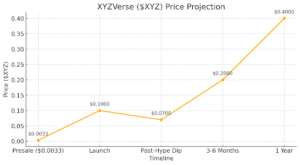Emerging blockchain platforms are gaining momentum, ready to surpass major players like Solana and Ethereum. With promises of faster speeds, lower costs, and better scalability, these projects are capturing attention. The crypto community is eager to see how these contenders might reshape the industry. Learn about the innovative networks poised to lead the next era of blockchain technology.
Graphite Token (@G): Powering the Blockchain That Could Topple Ethereum and Solana
Ethereum (ETH) and Solana (SOL) have had their time in the spotlight. Now, Graphite Token (@G) is here, bringing with it the power of the Graphite L1 blockchain designed to make crypto simpler, faster, and more rewarding for everyone. Could this be the next big thing to follow Ethereum’s legendary 4,000X growth?
The secret to life-changing crypto profits lies in spotting the next hidden gem before the crowd. History shows that early adopters of projects with real utility reap massive rewards:
- Solana started at $0.04 and skyrocketed to nearly $300 — a staggering +7,500%.
- Ethereum launched below $1 and climbed to around $4,000 — an insane +400,000%.
The secret to their growth? Utility. The more people use them, the more valuable their tokens become. But times have changed, and these blockchains aren’t cutting it anymore.
Discover SOL and ETH Challenger for 4,000X Profit Potential
What’s Wrong with Ethereum and Solana?
Older blockchains face growing challenges like rising fees, complexity, regulatory uncertainty, and questions about reliability. Take Solana, which occasionally experiences network outages, or Ethereum, which saw a significant reduction in its burn rate in 2024.
Between unpredictable gas costs, unsatisfactory speed, and unreliable service, users are starting to look elsewhere. The dominance of the “old guard” is fading.
What Graphite Brings to the Table
Graphite is built to address the challenges of older blockchains with a set of practical features.
Direct Rewards for Entry-Point Nodes
Graphite has something no other blockchain offers. It lets entry-point nodes earn 50% of transaction fees passing through their nodes, so literally anyone contributing to its operations can earn a share.
Transparent, Trust-Based Interactions
Graphite’s reputation-based system introduces a Trust Score, a measure of user credibility similar to a credit rating in TradFi. This approach enhances transparency while keeping user privacy within the network where interactions are built on trust.
Fair Fees, Fast Speed, and High Scalability
Powered by the PoA Polymer 2.0 Algorithm, Graphite keeps fees plain and as low as possible by minimizing computational and energy costs. The network processes up to 1,400 transactions per second with confirmation times under 10 seconds, delivering a perfect balance of speed, cost-efficiency, and reliability.
Security as a Top Priority
Graphite enforces a one user – one account policy to safeguard its network against fraud and scams. Additionally, it offers an optional KYC verification procedure with three tiers of off-chain checks powered by ZKP to ensure compliance while protecting user data. With transaction filters, users can choose to interact only with accounts that meet specific KYC levels, adding an extra layer of security.
Is This Your Chance to Get in Early?
The Graphite blockchain is secure, transparent, scalable, and cost-efficient, making it the go-to choice for developers and users alike. With its practical approach and early adoption potential, Graphite is a project worth watching.
For those looking to get in early, Graphite offers an opportunity to be part of a blockchain that’s designed for long-term growth and usability. Will it deliver 4,000X gains? Time will tell, but the foundation is strong.
This could be your shot at 4,000X profits — Don’t miss out!
Polkadot (DOT)
Developed by Dr. Gavin Wood, a co-founder of Ethereum, Polkadot aims to enable different blockchains to interoperate seamlessly.
Strengths:

- Interoperability: Facilitates communication between various blockchains, enhancing scalability and functionality.
- Parachain Architecture: Allows multiple parallel blockchains (parachains) to process transactions simultaneously, increasing throughput.
- Robust Governance: On-chain governance mechanisms enable stakeholders to vote on protocol upgrades and changes.
Potential: Polkadot’s unique approach to interoperability and scalability positions it as a strong competitor, especially as the demand for multi-chain solutions grows.
Avalanche (AVAX)
Avalanche is a highly scalable blockchain platform known for its high throughput and low latency.
Strengths:
- Consensus Mechanism: Utilizes the Avalanche consensus protocol, which allows for thousands of transactions per second with finality in seconds.
- Subnet Architecture: Supports the creation of custom blockchains (subnets) tailored to specific applications or regulatory requirements.
- EVM Compatibility: Enables easy migration of Ethereum-based decentralized applications (dApps) to Avalanche.
Potential: Avalanche’s emphasis on speed and flexibility makes it attractive for developers seeking alternatives to Ethereum’s scalability challenges.
Cardano (ADA)
Cardano is a research-driven blockchain platform focused on security, scalability, and sustainability.
Strengths:
- Peer-Reviewed Research: Employs a scientific approach to development, ensuring robustness and reliability.
- Ouroboros Proof-of-Stake: A secure and energy-efficient consensus mechanism.
- Focus on Sustainability: Implements governance models that emphasize long-term viability and community involvement.
Potential: Cardano’s methodical development and emphasis on formal verification could attract projects requiring high assurance, potentially increasing its adoption.
Algorand (ALGO)
Algorand is designed for speed, security, and decentralization, aiming to create a borderless economy.

Strengths:
- Pure Proof-of-Stake (PPoS): Ensures security and scalability while maintaining decentralization.
- Fast Finality: Transactions are finalized in seconds, supporting high-frequency trading and real-time applications.
- Developer-Friendly: Provides comprehensive tools and support for building dApps and smart contracts.
Potential: Algorand’s balance of speed and security makes it suitable for a wide range of applications, potentially attracting the significant developer and user base.
Cosmos (ATOM)
Cosmos aims to create an “Internet of Blockchains” by enabling different blockchains to communicate and interact.
Strengths:
- Inter-Blockchain Communication (IBC): Facilitates seamless data and asset transfer between heterogeneous blockchains.
- Modular Architecture: Allows developers to build custom blockchains tailored to specific use cases.
- Scalability: Supports high transaction throughput through parallel processing across multiple zones.
Potential: As the demand for interconnected blockchain ecosystems grows, Cosmos’s infrastructure could become increasingly valuable, positioning it as a key player.
Fantom (FTM)
Fantom is a high-performance blockchain platform optimized for DeFi, enterprise applications, and digital assets.
Strengths:
- Lachesis Protocol: An asynchronous Byzantine Fault Tolerant (aBFT) consensus mechanism that ensures high speed and security.
- Scalability: Capable of handling thousands of transactions per second with low fees.
- EVM Compatibility: Supports Ethereum-based dApps, facilitating easy migration and integration.
Potential: Fantom’s focus on DeFi and enterprise solutions, combined with its scalability, positions it well to capture significant market share.
Conclusion
While Solana (SOL) and Ethereum (ETH) remain key players, their short-term potential appears limited due to ongoing challenges. The projects mentioned above possess unique features and innovations that could enable them to outperform these established platforms. Specifically, Graphite Token (@G) is driving innovation with the Graphite L1 blockchain, aiming to simplify cryptocurrency use. It offers unmatched speed, high capacity, and rewarding features. By addressing issues like Ethereum’s high fees and Solana’s network outages, Graphite provides practical solutions such as fair transaction costs, a reputation-based Trust Score system, and a unique reward model where entry-point nodes earn 50% of transaction fees. For early adopters, it presents an exciting opportunity to engage with a project designed for long-term utility and growth.
How to buy Graphite Token (@G)
The post Top Blockchain Projects Ready to Outperform Solana and Ethereum appeared first on ETHNews.


